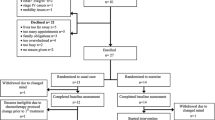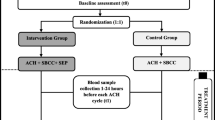Abstract
Introduction
Preclinical data demonstrate the potential for exercise training to protect against anthracycline-related cardiotoxicity, but this remains to be shown in humans.
Purpose
To assess whether exercise training during anthracycline-based chemotherapy for treatment of breast cancer affects resting cardiac function and hemodynamics.
Methods
In this prospective, non-randomized controlled study, 26 women who participated in aerobic and resistance training 3×/wk during chemotherapy were compared to 11 women receiving usual care. Two-dimensional echocardiography was performed before and 7–14 days after completion of anthracycline-based chemotherapy. Pre- and post-anthracycline cardiac function and hemodynamic variables were compared within each group with paired t-tests; the change was compared between groups using ANCOVA with adjustment for baseline values.
Results
Left ventricular longitudinal strain, volumes, ejection fraction, E/A ratio, and mass did not change in either group. Hemoglobin, hematocrit, and mean arterial pressure decreased significantly from baseline in both groups (all p < 0.05) with no differences between groups. Cardiac output increased in the usual care group only (+ 0.27 ± 0.24 L/min/m2, p < 0.01), which differed significantly from the exercise group (p = 0.03). Systemic vascular resistance (SVR) decreased in both groups (usual care: − 444, p < 0.01; exercise: − 265, dynes/s/cm5, p = 0.01). However, the reduction in SVR was significantly attenuated in the exercise group (p = 0.03) perhaps due to a compensatory decrease in estimated vessel lumen radius.
Conclusion
Exercise training during anthracycline chemotherapy treatment had no effect on resting cardiac function but appeared to modify hemodynamic responses. Specifically, exercise training attenuated the drop in SVR in response to chemotherapy-related reductions in hematocrit potentially by increasing vessel lumen radius.

Similar content being viewed by others
Data availability
The datasets during and/or analyzed during the current study are available from the corresponding author on reasonable request.
References
Henderson IC (2011) Can we abandon anthracyclines for early breast cancer patients? Oncology 25:115–124
Beisecker A, Cook MR, Ashworth J, Hayes J, Brecheisen M, Helmig L et al (1997) Side effects of adjuvant chemotherapy: perceptions of node-negative breast cancer patients. Psycho-Oncol 6:85–93
Bird BRJH, Swain SM (2008) Cardiac toxicity in breast cancer survivors: review of potential cardiac problems. Clin Cancer Res 14:14–24
Witteles RM, Fowler MB, Telli ML (2011) Chemotherapy-associated cardiotoxicity: how often does it really occur and how can it be prevented? Heart Fail Clin 7:333–344
Kalam K, Marwick TH (2013) Role of cardioprotective therapy for prevention of cardiotoxicity with chemotherapy: a systematic review and meta-analysis. Eur J Cancer 49:2900–2909
Kirkham AA, Davis MK (2015) Exercise prevention of cardiovascular disease in breast cancer survivors. J Oncol 2015:1–13
Kirkham AA, Eves ND, Shave RE, Bland KA, Bovard J, Gelmon KA, Virani SA, McKenzie DC, Stohr EJ, Warburton DER, Campbell KL (2018) The effect of an aerobic exercise session 24h prior to each doxorubicin treatment for breast cancer on markers of cardiotoxicity and treatment symtoms: a RCT. Breast Cancer Res Treat 167:719–729
Schmitz KH, Courneya K, Matthews C, Demark-Wahnefried W, Galvão DA, Pinto BM et al (2010) American College of Sports Medicine roundtable on exercise guidelines for cancer survivors. Med Sci Sports Exerc 42:1409–1426
Taylor HL, Jacobs DR, Schucker B, Knudsen J, Leon AS, Debacker G (1978) A questionnaire for the assessment of leisure time physical activities. J Chron Dis 31:741–755
Godin G, Shephard RJ (1997) Godin leisure-time exercise questionnaire. Med Sci Sports Exerc 29:S36
Thavendiranathan P, Poulin F, Lim K-D, Plana JC, Woo A, Marwick TH (2014) Use of myocardial strain imaging by echocardiography for the early detection of cardiotoxicity in patients during and after cancer chemotherapy: A systematic review. J Am Coll Cardiol 63:2751–2768
Lang RM, Badano LP, Mor-Avi V, Afilalo J, Armstrong A, Ernande L et al (2015) Recommendations for cardiac chamber quantification by echocardiography in adults: an update from the American Society of Echocardiography and the European Association of Cardiovascular Imaging. J Am Soc Echocardiogr 28:1–39.e14
Dogru A, Cabuk D, Sahin T, Dolasik I, Temiz S, Uygun K (2013) Evaluation of cardiotoxicity via speckle-tracking echocardiography in patients treated with anthracyclines. Onkologie 36:712–716
Stöhr EJ, González-Alonso J, Pearson J, Low DA, Ali L, Barker H et al (2010) Effects of graded heat stress on global left ventricular function and twist mechanics at rest and during exercise in healthy humans. Exp Physiol 96:114–124
Mosteller RD (1987) Simplified calculation of body-surface area. New Engl J Med 317:1098–1108
Sloop GD, Weidman JJ, St Cyr JA (2015) The systemic vascular resistance response: a cardiovascular response modulating blood viscosity with implications for primary hypertension and certain anemias. Ther Adv Cardiovasc Dis 9:403–411
Howden EJ, Bigaran A, Beaudry R, Fraser S, Selig S, Foulkes S et al (2019) Exercise as a diagnostic and therapeutic tool for the prevention of cardiovascular dysfunction in breast cancer patients. Eur J Prev Cardiol 26:305–315
Hornsby WE, Douglas PS, West MJ, Kenjale AA, Lane AR, Schwitzer ER et al (2014) Safety and efficacy of aerobic training in operable breast cancer patients receiving neoadjuvant chemotherapy: a phase II randomized trial. Acta Oncol 53:65–74
Wisloff U, Ellingsen O, Kemi OJ (2009) High-intensity interval training to maximize cardiac benefits of exercise training? Exerc Sport Sci Rev 37:139–146
Marques-Aleixo I, Santos-Alves E, Mariani D, Rizo-Roca D, Padrão AI, Rocha-Rodrigues S et al (2015) Physical exercise prior and during treatment reduces sub-chronic doxorubicin-induced mitochondrial toxicity and oxidative stress. Mitochondrion 20:22–33
Sturgeon K, Schadler K, Muthukumaran G, Ding D, Bajulaiye A, Thomas NJ et al (2014) Concomitant low-dose doxorubicin treatment and exercise. Am J Physiol Regul Integr Comp Physiol 307:R685–R692
Kirkham AA, Lloyd MG, Claydon VE, Gelmon KA, McKenzie DC, Campbell KL (2019) A longitudinal study of the association of clinical indices of cardiovascular autonomic function with breast cancer treatment and exercise training. Oncologist 24:273–284
Kirkham AA, Van Patten C, Gelmon KA, McKenzie DC, Bonsignore A, Bland KA, Campbell KL (2018) Effectiveness of oncologist-referred exercise and healthing eating programming as part of supportive adjuvant care for early breast cancer. Oncologist 23:105–115
Funding
This work was supported by the American College of Sports Medicine Foundation (2013–2015); the British Columbia Cancer Agency (2014–2016). Dr. Kirkham was supported by the Canadian Institutes of Health Research (2010–11, 2012–14) and the University of British Columbia Four-year Fellowship (2010–11, 2012–15).
Author information
Authors and Affiliations
Contributions
All authors contributed to the study conception and design. Material preparation, data collection, and analysis were performed by AK and KB. The first draft of the manuscript was written by AK and KC and all authors commented on previous versions of the manuscript. All authors read and approved the final manuscript.
Corresponding author
Ethics declarations
Conflict of interest
The authors declare that they have no conflicts of interest.
Ethics approval
The British Columbia Cancer Agency (H12-02504) and University of British Columbia Research (H13-03090) Ethics Boards approved this research. The study was performed in accordance with the ethical standards as laid down in the 1964 Declaration of Helsinki and its later amendments or comparable ethical standards.
Consent to participate
Informed consent was obtained from all individual participants included in the study.
Additional information
Publisher's Note
Springer Nature remains neutral with regard to jurisdictional claims in published maps and institutional affiliations.
Rights and permissions
About this article
Cite this article
Kirkham, A.A., Virani, S.A., Bland, K.A. et al. Exercise training affects hemodynamics not cardiac function during anthracycline-based chemotherapy. Breast Cancer Res Treat 184, 75–85 (2020). https://doi.org/10.1007/s10549-020-05824-x
Received:
Accepted:
Published:
Issue Date:
DOI: https://doi.org/10.1007/s10549-020-05824-x




